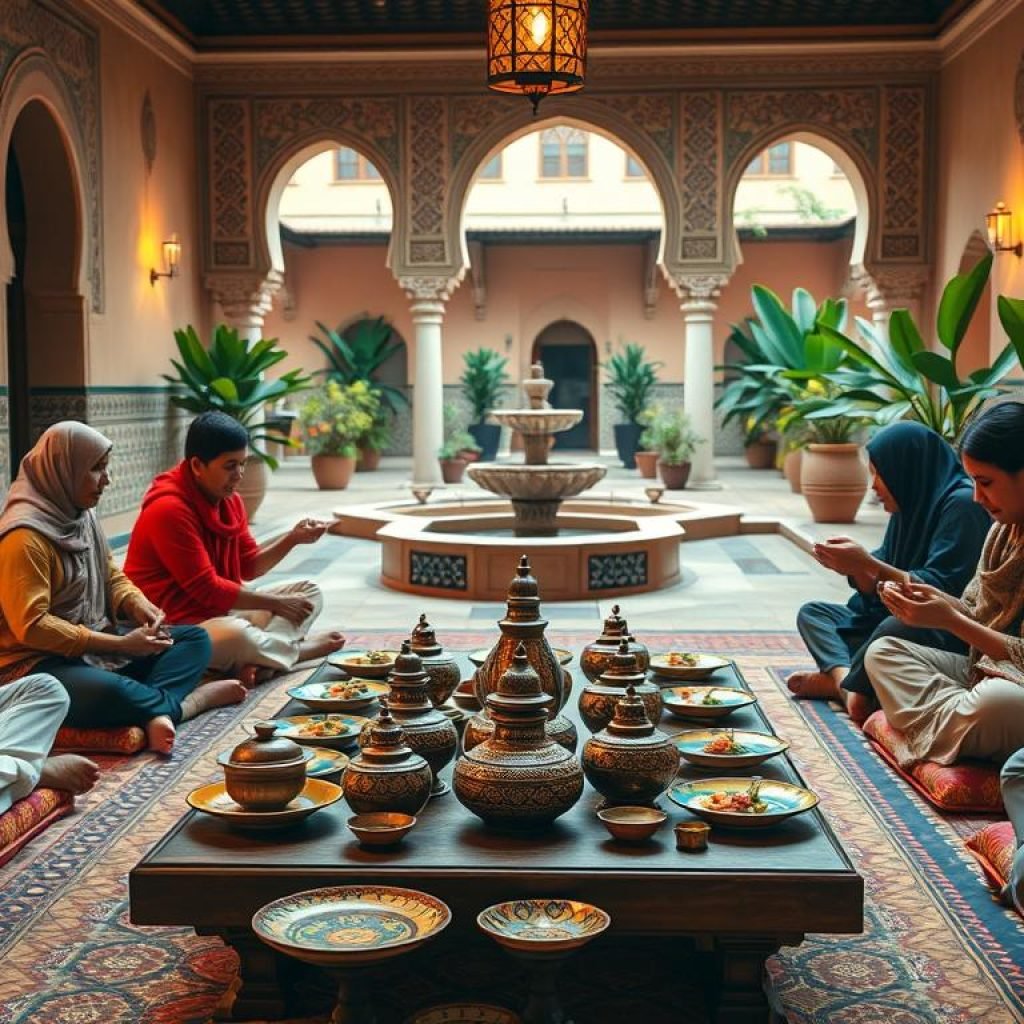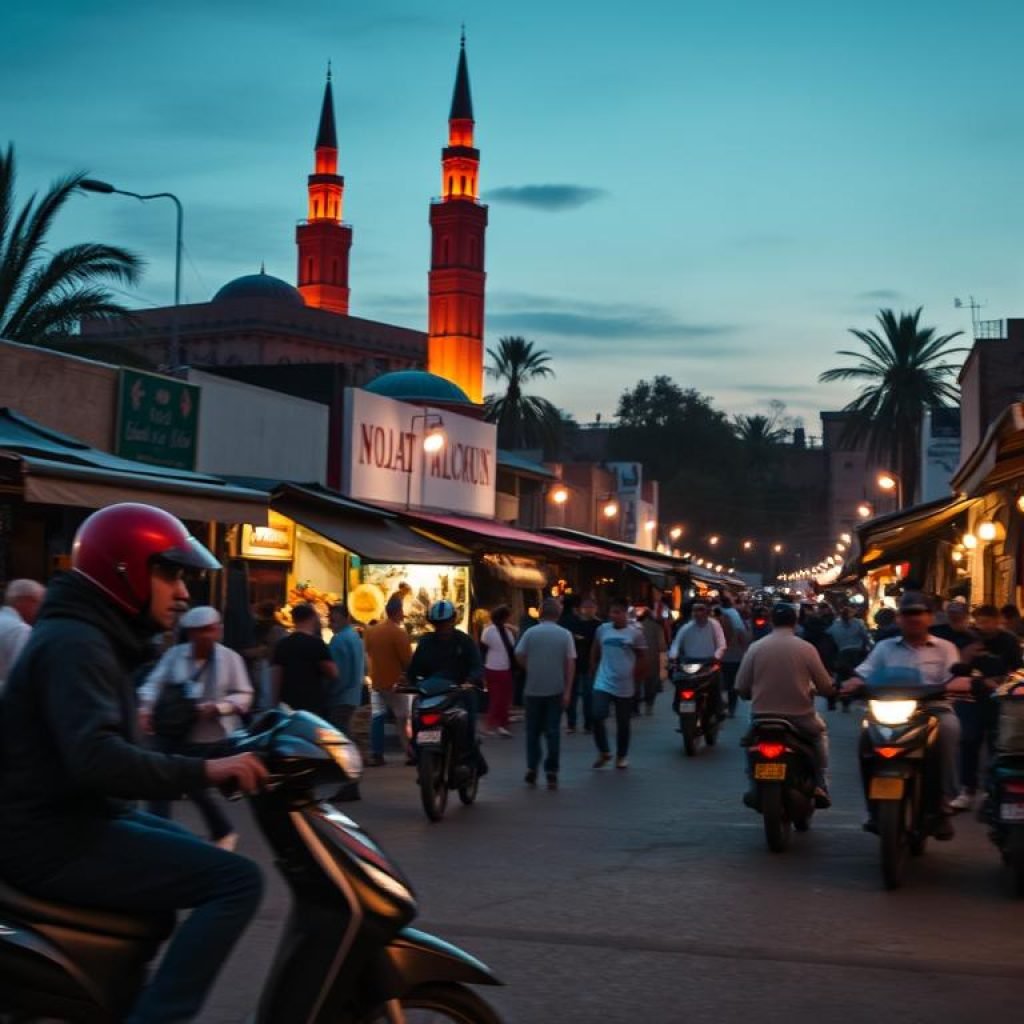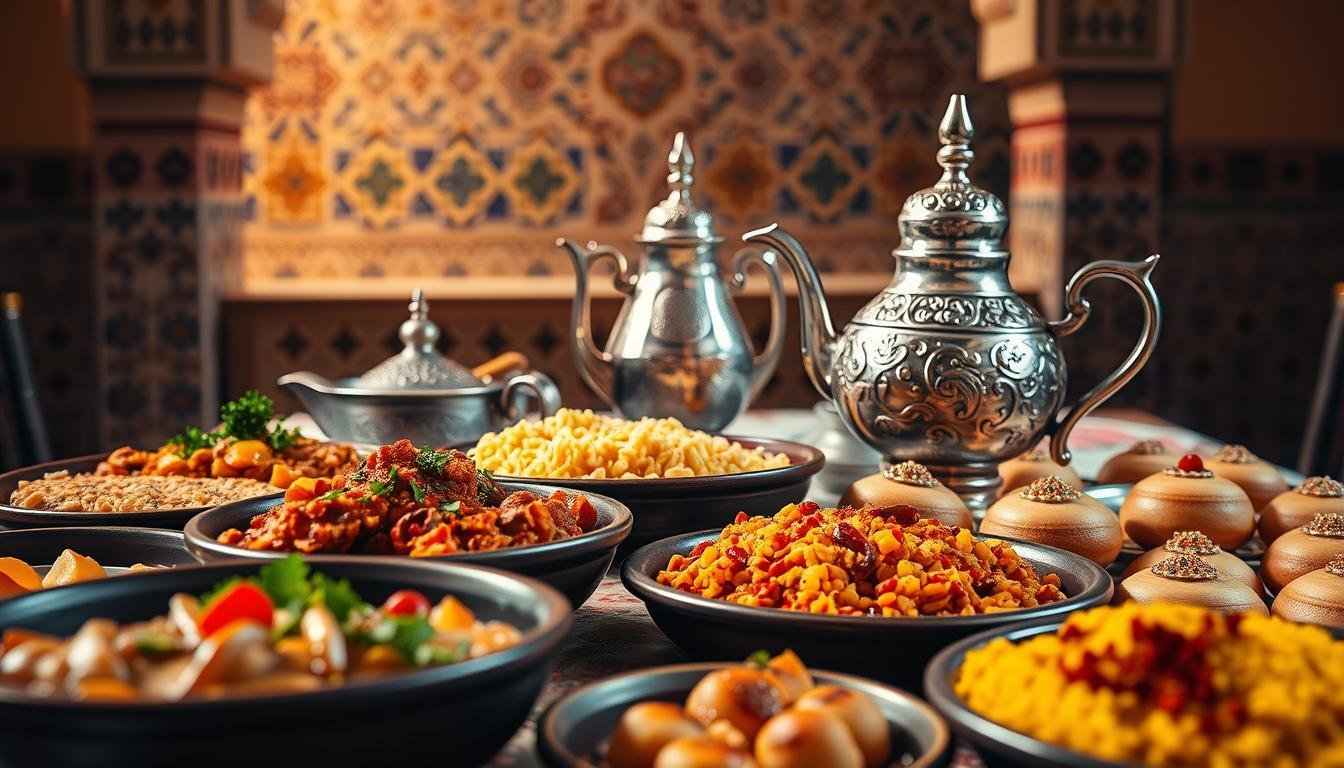Are you ready to explore Morocco’s rich flavors and aromas? Morocco mixes African, Arab, and European tastes, offering a wide range of dishes. From traditional tagines to street food, it’s perfect for food tours. Knowing how to order like a local will enhance your dining experiences.
Imagine enjoying a refreshing mint tea or a flavorful tagine. Most restaurants have menus in French, with English menus being rare. It’s key to understand local customs and traditions, like tipping 10 percent in restaurants. Morocco offers many dishes, including vegetarian options and traditional pastries.
Exploring Moroccan cuisine is more than just eating. It’s about the experience. With food tours and experiences, you’ll discover Morocco’s culinary heritage. So, what do you need to know when ordering food in Morocco, and how can you enjoy your culinary adventures?
Key Takeaways
- Understanding local customs and traditions is crucial when ordering food in Morocco
- Moroccan cuisine offers a unique blend of African, Arab, and European influences
- Tipping is expected in restaurants, with a rate of 10 percent
- Vegetarian options are commonly available, and traditional pastries are a must-try
- Morocco food tours and Moroccan cuisine experiences provide an unforgettable culinary adventure
- Respecting local dining etiquette and traditions will enhance your overall experience
Understanding Moroccan Cuisine
Starting a culinary journey in Morocco is thrilling. You’ll find a variety of authentic Moroccan food experiences. Moroccan food is a mix of flavors and spices that you’ll love.
Traditional dishes like couscous, tagine, and harira are key to Moroccan cuisine. These dishes are not just tasty but also carry deep cultural meaning. Couscous, for example, is Morocco’s national dish. Trying these dishes is essential on your culinary journey in Morocco. They’re made with spices like cumin, ginger, and cinnamon.
For a real authentic Moroccan food experience, don’t miss the street food. Try brochettes or bastilla. These dishes are delicious and give you a peek into Moroccan daily life and culture. Moroccan cuisine’s rich flavors and aromas will make your culinary journey in Morocco unforgettable.
Cultural Etiquette When Dining
When you join Best food tours in Morocco, knowing the local dining rules is key. It makes your experience better and shows respect. In Morocco, it’s important to use your right hand when eating. This is because the left hand is seen as unclean.
Guests usually get the best food, showing the country’s love for hospitality. This is a big part of Moroccan dining culture.
In Morocco, meals are shared from a big dish, and you won’t see much silverware. Bread is very important here. It’s used as a tool and eaten often during the day.
For a real taste of Morocco, try Taste of Morocco tours. They let you see how food and traditions are woven together.

Table Manners
Table manners in Morocco focus on respect and being welcoming. Before meals, it’s common to wash your hands. This is often done with scented water like rose or orange.
The meal starts when the host says “Bismillah” and everyone repeats it. This is a sign of respect and unity.
Eating Customs
Eating customs in Morocco are unique and show the local culture. It’s polite to keep eating even if you’re full. Stopping might mean the meal is over.
Allergies are rare in Morocco. Many people don’t know about gluten allergies or other less common ones.
Greetings and Interaction
Greetings and how you interact are important in Moroccan dining. Arabic and French are the main languages, but some places have English menus. This helps tourists communicate better.
Being polite and respectful is crucial when talking to locals. Saying “as-salamu alaykum” (peace be upon you) is a good way to greet them.
Where to Order Food in Morocco
Visitors to Morocco have many places to find great food. You can try popular restaurants, cafés, food markets, and souks. For a real taste of Morocco, Top-rated food tours Morocco are a great choice.
In big cities, you’ll find many restaurants with traditional Moroccan dishes like tagines and couscous. These places offer vegetarian and vegan options too. Joining Delicious Moroccan dishes tours lets you try local food while exploring markets and souks.
Morocco also has food markets and souks where you can try traditional dishes and drinks. Here, you can taste fresh juices, mint tea, and pastries. With so many choices, you’re sure to find something you like.
Utilizing Food Delivery Apps in Morocco
Exploring food and culture tours in Morocco is better with food delivery apps. They let tourists enjoy local food from their own place. Glovo is a popular app in many Moroccan areas, connecting users to local eateries and shops.
Using these apps is simple. You can see how long it will take and how much it will cost. For example, Glovo’s delivery times and fees depend on where you are and how far the food is from you. You can pay with cards, PayPal, or Google Pay, making it easy to order.
Some key features of food delivery apps in Morocco include:
- Colored images indicating restaurant availability
- Promo codes for discounts on orders
- Same-day delivery options with certain apps, such as IzzaFood and Marjane
- Various payment options, including credit/debit cards and online payment services
Food delivery apps let tourists dive into food and culture tours in Morocco without leaving their rooms. They offer delivery and many ways to pay, making it simple to try local dishes.

Overall, food delivery apps are a fantastic way to taste Morocco’s flavors. With the right app, tourists can have a smooth and fun experience.
Ordering Food in Restaurants: A Step-by-Step Guide
Exploring Morocco’s food scene is exciting. Knowing how to order in restaurants is key. Morocco food tours let you try local dishes in different eateries. It’s important to understand menus and talk to your server.
Reading the menu is a big part of ordering. Many places in Morocco have menus in English, French, and Arabic. If you’re unsure, ask your server for advice. They can guide you to dishes that fit your taste and diet.
Telling your server about dietary restrictions is crucial. Moroccan dishes often have common allergens like nuts and gluten. Being open helps ensure a safe and fun meal.
Must-try dishes include tagines, couscous, and harira. These are staples in Morocco’s restaurants and food stalls. A Morocco food tour lets you taste these dishes and learn about the country’s food culture.
The Role of Tipping in Moroccan Dining
When you enjoy Authentic Moroccan food experiences, knowing about tipping is key. Tipping is a big part of Moroccan culture. It shows you value the service you get.
In Morocco, the minimum wage is low. So, tips are a big help for many workers.
For Best food tours in Morocco, aim to tip 10% to 15% of the bill. But, the amount can change based on the place and service. For example, at cafes or small places, 5% to 10% or 5 to 10 dirhams per person is okay. But, at nicer restaurants, expect to tip 10% to 15% of the bill.
- Petit taxi drivers: round up to 5 or 10 dirhams
- Airport transfer: 20 to 50 dirhams per person or 100 dirhams per booking party
- Local transfer: 10 to 20 dirhams per person or 50 dirhams per booking party
- Multi-day tour drivers: 100 dirhams per day per booking party
Tipping is a way to thank good service. It’s important to respect local customs. By tipping right, you’ll have a great time and enjoy your Authentic Moroccan food experience and Best food tours in Morocco.
Navigating Food Options for Special Diets
Visitors with special dietary needs in Morocco can find tasty and safe food. Taste of Morocco tours and Top-rated food tours Morocco have raised awareness. Many traditional dishes are gluten-free, and dairy is rare in cooking.
Morocco now has more vegetarian and vegan choices. The Earth Cafe in Marrakech is a standout for plant-based meals. La Creperie du Marrakech offers gluten-free crepes from France.
Carrefour or Marjane markets have non-dairy milk. Many places can handle food allergies. NIYA Casablanca, a vegan spot, has gluten-free dishes like tom kha soups and pizza.
It’s key to talk to restaurant staff about dietary needs. They often can make special dishes. This way, everyone can enjoy Morocco’s rich flavors, from tagines to vegan breakfasts, on Taste of Morocco tours and Top-rated food tours Morocco.
Understanding Moroccan Dining Times
Exploring Morocco’s rich food scene means knowing when to eat. This knowledge makes your experience better. You’ll enjoy the tasty dishes on Delicious Moroccan dishes tours and Food and culture tours in Morocco. Breakfast starts the day with breads and pancakes like msemen, baghrir, and harcha.
Lunch is from noon to 3 PM, followed by a tea break from 5-7 PM. This is the perfect time for Moroccan mint tea, sweetened just right. Dinner starts at 7 PM and can go late into the night.
Food and culture tours in Morocco let you see the local way of life. You’ll visit markets and try foods like tagines, couscous, and fresh orange juice. By knowing and respecting local times and customs, you’ll dive deep into Moroccan culture. You’ll also experience the country’s famous warm hospitality.
Communication Tips for Tourists
When you start a culinary journey in Morocco, talking well is very important. About 33% of Moroccans speak French, mainly in cities. Learning a few basic phrases can really help. For example, asking for food recommendations or saying what you like can make a big difference.
Knowing the local culture and language helps you in daily life. Saying “Salam” (hello) in Moroccan Arabic is a good way to start a conversation. Also, knowing phrases like “Labas?” (How are you?) and “Mashi Mushkil” (No problem) can help you connect with people.
Here are some essential phrases to get you started:
- Salam (hello)
- Shukran (thank you)
- Labas? (How are you?)
- Mashi Mushkil (No problem)
- Goli Taman? (What’s the price?)
- Mzyan (Good)
By learning these phrases and being open to new experiences, you can have a more authentic and fun culinary journey in Morocco. Whether you’re checking out local markets or joining a guided food tour, talking well can make your trip better.
Food Safety Tips While Eating Out
Exploring Authentic Moroccan food experiences means keeping food safety in mind. Morocco has a lot of tasty food, from traditional dishes to street food. Knowing how to stay safe can make your meals worry-free. It’s important to find clean places to eat and follow safe food habits, even on Best food tours in Morocco.
Food poisoning is a big concern. The Ministry of Health says about 1,600 cases happen every year in Morocco. To stay safe, avoid raw or undercooked foods, and choose meals that are cooked fresh.
- Avoid eating raw or unpeeled fruits and vegetables, as they may be contaminated with human or animal waste.
- Choose restaurants and cafes that have a good reputation and follow proper food handling practices.
- Be cautious of foods that are left at room temperature for an extended period, as they can be a breeding ground for bacteria.
- Drink bottled or filtered water, and avoid ice unless you’re certain it was made from properly filtered water.
By following these tips, you can enjoy Moroccan food safely. Always think about your health and safety. If you’re unsure, ask your tour guide or local authorities for advice on where to eat.
Exploring Unique Food Experiences in Morocco
Looking for a deeper taste of Moroccan cuisine? Morocco has a lot to offer. You can take hands-on cooking classes or join guided food tours. These experiences let you dive into the rich flavors of this North African nation.
Cooking classes and workshops are great for learning Moroccan recipes. The Amal Association, for instance, trains women in cooking and waitressing. These classes are small, with about ten guests, so you get lots of personal attention.
Or, try Taste of Morocco tours and top-rated food tours in Marrakesh and Fez. These tours take you through busy medinas. You’ll taste many local foods and see how communal baking works in every street. From fresh seafood in Essaouira to hearty Harira soup, these tours show off Morocco’s diverse cuisine.




Comment (0)